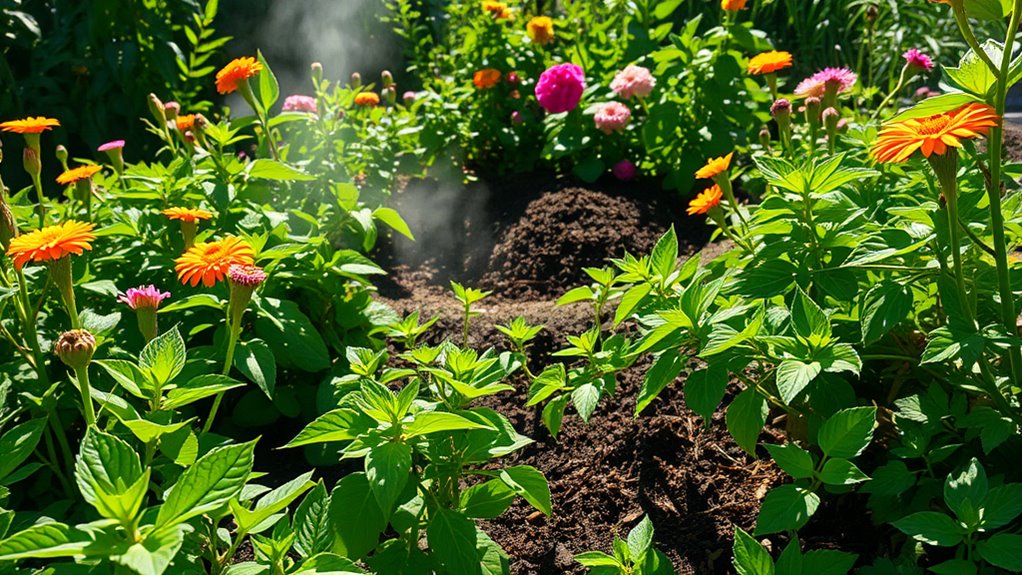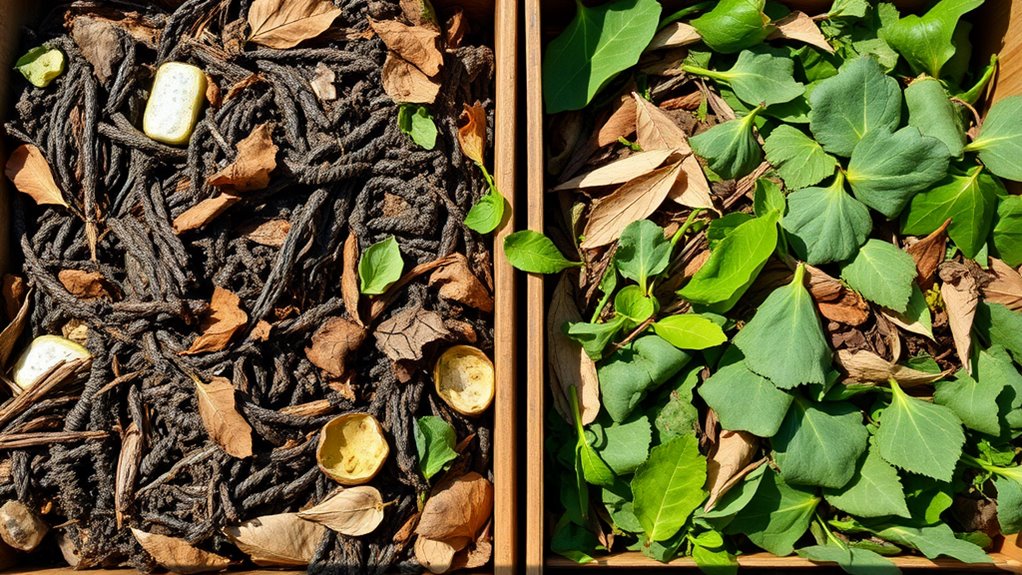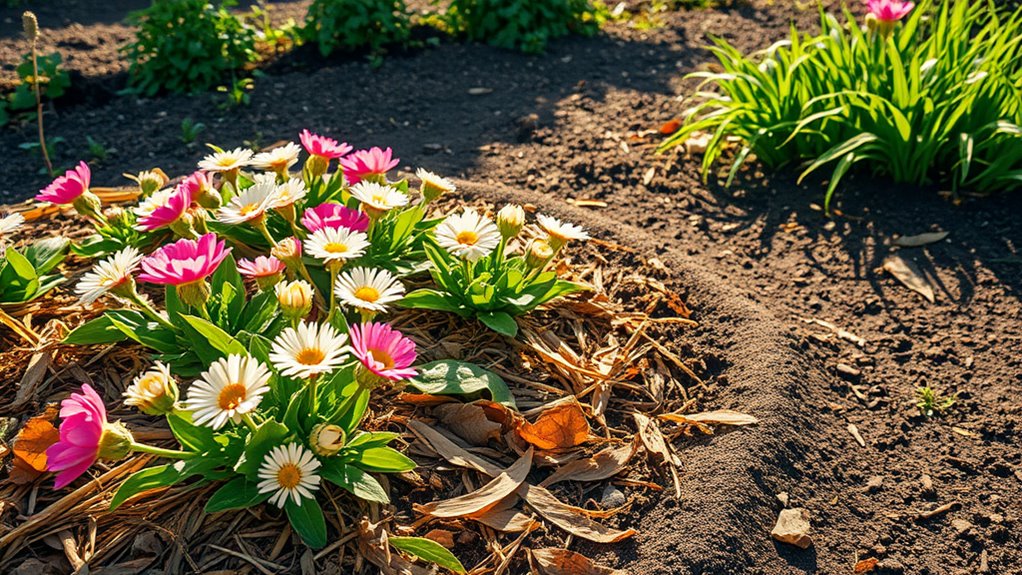How I Keep My Garden Thriving Year-Round – Without Chemicals
You’ll keep your garden thriving year-round without chemicals by rotating crops seasonally to prevent pests and building nutrient-rich soil through composting and cover crops. Manage bugs naturally with beneficial insects and companion planting, like pairing marigolds with tomatoes. Use drip irrigation and rainwater harvesting for efficient watering, while mulching and pruning maintain health through extreme weather. These strategies build resilience, paving the way for even more practical tips ahead.
Key Takeaways
- Rotate crops seasonally to maintain soil fertility and naturally deter pests.
- Compost kitchen scraps and yard waste to build nutrient-rich soil organically.
- Introduce beneficial insects like ladybugs to control pests without chemicals.
- Use drip irrigation for efficient watering and moisture conservation.
- Apply organic mulch to retain soil moisture and suppress weeds year-round.
Seasonal Preparation Techniques
Because seasons change predictably, you’ll need to prepare your garden strategically to maintain its health.
In seasonal organic gardening, you plan crop rotations to prevent pests naturally, selecting varieties that thrive in specific weather patterns. For instance, sow cool-season crops like kale in fall to leverage shorter days, while summer demands heat-tolerant plants such as tomatoes.
Actively monitor frost dates and adjust mulching to retain moisture organically. Prune perennials in spring to promote growth, ensuring biodiversity supports ecosystem balance.
Test for seasonal diseases early, using companion planting to deter issues without chemicals, keeping your garden vibrant year-round. Additionally, conducting soil testing before planting helps enhance plant health and prevent nutrient deficiencies.
Building Nutrient-Rich Soil
Nutrient-rich soil anchors your garden’s success, providing essential nutrients for robust plant growth. You build it by composting kitchen scraps and yard waste, which boosts organic matter and fosters beneficial microbes. Embracing the practice of turning kitchen scraps into nutrient-rich soil can significantly enhance your gardening efforts.
Test your soil’s pH and nutrient levels first—use a simple kit—to guide amendments. Add cover crops like clover to fix nitrogen naturally, or apply mulch from leaves to retain moisture and suppress weeds.
Rotate plantings to prevent nutrient depletion, ensuring long-term fertility. Remember, healthy soil means healthier plants, so monitor and adjust your methods seasonally for optimal results. Don’t forget to incorporate kitchen scraps such as fruit peels and vegetable trimmings to enhance your compost and promote sustainable practices.
Natural Pest Management Strategies
As you manage pests in your garden, you’ll find that introducing beneficial insects like ladybugs and lacewings offers a natural way to control harmful bugs without chemicals.
You can attract these helpful predators by planting nectar-rich flowers that provide them habitat and food.
Additionally, companion planting lets you pair vegetables such as marigolds with tomatoes to naturally repel pests through their emitted scents and compounds.
Another effective method is incorporating pest-repelling herbs like basil and mint to keep pests at bay.
Moreover, incorporating specific plant pairings can enhance garden health and increase crop yields for a thriving season.
Beneficial Insects
Beneficial insects, like ladybugs and lacewings, actively combat garden pests by preying on them, offering a sustainable alternative to chemicals. You can attract these allies by planting nectar-rich flowers, such as alyssum or dill, which provide habitat and food.
For instance, ladybugs devour aphids, while lacewings target mites and caterpillars, maintaining ecological balance. Monitor your garden regularly; introduce purchased insects if populations dip, but ensure they’re native to avoid disruptions.
This method reduces pest damage naturally, boosting biodiversity and yielding healthier plants without synthetic interventions. Remember, patience yields results as these predators establish.
Companion Planting
Companion planting strategically pairs plants to naturally repel pests and boost garden health, making it a key tactic in organic pest control.
You enhance your garden’s resilience by choosing companions that deter insects through chemical emissions or physical barriers, reducing the need for interventions.
-
Marigolds and tomatoes: You plant marigolds nearby to release compounds that repel nematodes, protecting tomato roots and improving yields.
-
Basil and vegetables: Interspersing basil deters aphids via its aromatic oils, fostering a balanced ecosystem.
-
Garlic and roses: Positioning garlic around roses wards off fungal diseases and pests like spider mites through sulfur compounds.
Efficient Watering Methods
You can adopt drip irrigation to deliver water precisely to your plant roots, reducing evaporation and waste.
It’s equally effective to set up rainwater harvesting systems that capture and store natural runoff for reuse.
These methods help you maintain optimal soil moisture while conserving resources in your garden.
Additionally, in extreme heat, these strategies ensure your plants stay hydrated and healthy, drawing from proven tips for thriving gardens.
Moreover, by mastering watering timing, you can further optimize your irrigation to maximize plant growth and minimize water usage.
Drip Irrigation Tips
Drip irrigation delivers water directly to plant roots, minimizing waste through targeted, low-flow methods. This approach lets you maintain optimal soil moisture while reducing evaporation and runoff, promoting deeper root growth and healthier plants.
It’s a scientifically proven way to boost efficiency in your chemical-free garden.
-
Select appropriate emitters: Match flow rates to your soil’s permeability—sandy soils need slower drips to avoid leaching nutrients.
-
Position tubing strategically: Place lines near plant bases for even distribution, using scientific spacing guidelines based on crop water needs.
-
Monitor and adjust pressure: Regularly test system pressure with a gauge to ensure consistent delivery, preventing blockages and water stress.
Rainwater Harvesting Methods
Rainwater harvesting captures and stores rooftop runoff, providing a sustainable alternative for garden hydration.
You’ll assess your roof area to calculate potential yield, then install gutters and downspouts directing water into barrels or tanks.
Scientifically, this method filters out contaminants via screens, yielding soft water that’s less saline than tap sources, promoting healthier soil microbes.
Connect systems to drip irrigation for efficient delivery, minimizing evaporation losses.
Use first-flush devices to exclude initial pollutants, and maintain by cleaning tanks biannually.
This approach reduces your water bills, conserves resources, and fosters an eco-friendly garden ecosystem.
Companion Planting Approaches
Companion planting offers several strategic methods to enhance garden productivity by pairing plants that mutually benefit each other. Reflecting on my first experience, I discovered that companion planting can lead to surprising results even for novice gardeners.
You’ll discover how these interactions boost your garden’s natural defenses, improve soil quality, and maximize space efficiency, all while avoiding chemicals. By implementing these approaches, you can create a balanced ecosystem that supports healthier growth.
These techniques are also supported by scientific principles that highlight specific plant combinations for better results.
-
Pest deterrence: Pair marigolds with tomatoes; their roots release compounds that repel nematodes, reducing pest damage scientifically proven in organic studies.
-
Nutrient enhancement: Interplant legumes like beans with corn; beans fix atmospheric nitrogen, enriching soil for nearby plants through symbiotic bacteria.
-
Growth optimization: Combine tall sunflowers with shade-loving lettuce; this arrangement maximizes light use and space, promoting efficient photosynthesis and yields.
Year-Round Maintenance Tips
To keep your garden flourishing beyond planting strategies, you’ll need to adopt consistent maintenance routines that address seasonal changes and promote long-term health. Start by monitoring soil moisture and pH weekly with simple tests to maintain balance. Prune plants actively to boost airflow and reduce disease risk, while mulching suppresses weeds and retains water efficiently. By using mulch, you can unlock its transformative power for improved soil health and pest control. Use drip irrigation for precise watering, minimizing waste. During heatwaves, employing organic techniques can help your garden withstand extreme temperatures naturally.
| Season | Maintenance Task | Scientific Benefit |
|---|---|---|
| Spring | Aerate and test soil | Enhances microbial activity |
| Summer | Deep, infrequent water | Builds drought resilience |
| Fall | Apply organic mulch | Improves soil structure |
| Winter | Prune dormant growth | Stimulates spring recovery |





